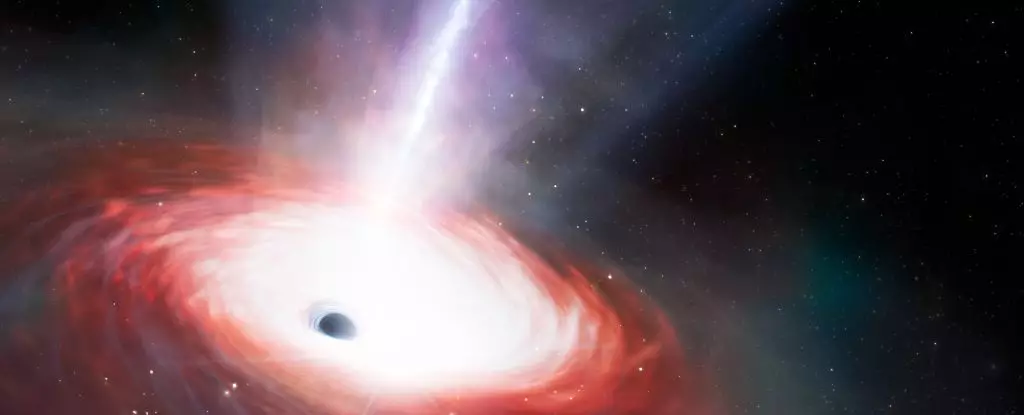The cosmos presents an ever-fascinating array of mysteries, and among them, supermassive black holes stand out as some of the most perplexing celestial entities. Recent observations have unveiled a particularly remarkable specimen located in a galaxy known as LID-568. This massive black hole is situated about 1.5 billion years after the Big Bang, and it challenges our understanding of black hole formation and growth in the early universe. What makes LID-568 captivating is its astonishing accretion rate, which has been measured at over 40 times the Eddington limit, a threshold believed to govern the maximum amount of material a black hole can consume under normal conditions.
The Eddington limit serves as a crucial marker in astrophysics, delineating the balance between a black hole’s gravitational pull and the outward pressure exerted by radiation emitted from the accretion disk—the disk of swirling material that surrounds and falls into the black hole. When a black hole feeds, matter spirals inward, and as this interaction generates immense friction, the surrounding material heats up, resulting in radiant energy emission. This radiation produces an outward force, which counters the gravitational pull of the black hole. If the accretion exceeds this limit, it leads to a phenomenon called super-Eddington accretion.
In the case of LID-568, the evidence points to an extraordinary event where conventional physics ceases to apply. Such high rates of material consumption challenge the previously held beliefs regarding the processing of matter in black holes, particularly at such an early stage in cosmic history. Astronomer Julia Scharwächter from the Gemini Observatory referred to this black hole’s feasting habits when she stated, “This extreme case shows that a fast-feeding mechanism above the Eddington limit is one of the possible explanations for why we see these very heavy black holes so early in the Universe.”
The recent study led by Hyewon Suh leveraged the advanced capabilities of the James Webb Space Telescope (JWST) to investigate LID-568. While earlier observations from the Chandra X-ray Observatory signaled the bright X-ray emissions from this galaxy, they provided limited clarity regarding its distance in the cosmic landscape. The JWST played a pivotal role in securing detailed follow-up observations, utilizing its integral field spectrograph on the Near Infrared Spectrograph (NIRSpec) instrument to meticulously identify the galaxy’s position.
The remarkable off-state brightness indicated that, despite appearing faint, LID-568 must inherently possess an extreme luminosity. Upon further analysis, powerful outflows—indicative of intense accretion processes—were noted, hinting at material being expelled into space rather than solely being consumed by the black hole.
What is particularly intriguing is the measurement of the black hole’s mass, estimated at about 7.2 million times that of our Sun. Typically, one would expect the light output and the accretion flow to correlate with the black hole’s mass; however, LID-568 defies such expectations. The luminosity being produced dwarfs what one would anticipate from a black hole of this size, suggesting an accretion rate that vastly exceeds theoretical projections.
Such apparently impossible conditions raise several significant questions about black hole evolution in the early universe. Could it be that these black holes formed through processes that are distinct from those posit using conventional stellar mechanics? Indeed, earlier theories suggest that the progenitors of these supermassive entities might have collapsed from massive stars or large gas clumps directly under the force of gravity, presenting a different path for their rapid formation.
The discovery of LID-568 and its peculiar accretion mechanics could provide critical insights into the conditions surrounding the universe’s infancy. While it is challenging to study the formative phases of supermassive black holes, the unique characteristics of LID-568 may allow astronomers to glean valuable information regarding the methods behind their formation and growth.
The possibility of super-Eddington accretion bursts as a contributing factor to the rapid assembly of supermassive black holes could redefine our understanding of black hole evolution. Observations of LID-568 exemplify the need for ongoing research into these intriguing formations and their position in the cosmic timeline.
As scientists focus on LID-568 for further examination, this galaxy may become a focal point in addressing not only the life cycles of black holes but also the overarching narrative of cosmic evolution in the depths of space-time, challenging preconceived notions and disciplines within astrophysics. The deeper we delve into these phenomena, the more complex and enriched our understanding of the universe will become.

